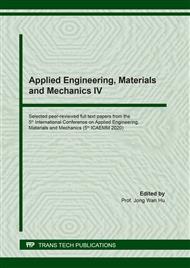[1]
H. C. J. Godfray, J. R. Beddington, et al., Food Security: The Challenge of Feeding 9 Billion People, Sci. 327(5967) (2010) 812-818.
DOI: 10.1126/science.1185383
Google Scholar
[2]
S. Bleakley, M. Hayes, Algal Proteins: Extraction, Application, and Challenges Concerning Production, Foods, 6 (2017) 2-34.
DOI: 10.3390/foods6050033
Google Scholar
[3]
S. Collins, N. Dent, P. Binns, P. Bahwere, K. Sadler, A. Hallam, Management of severe acute malnutrition in children., Lancet. 368 (2006) 1992-2000.
DOI: 10.1016/s0140-6736(06)69443-9
Google Scholar
[4]
A. L. Lupatini, L. de Oliveira Bispo, L. M. Colla, J. A. V. Costa, C. Canan, E. Colla, Protein and carbohydrate extraction from S. platensis biomass by ultrasound and mechanical agitation, Food Res. Int. 99 (2017) 1028-1035.
DOI: 10.1016/j.foodres.2016.11.036
Google Scholar
[5]
H. Hadiyanto, N. P. Adetya, Response surface optimization of lipid and protein extractions from Spirulina platensis using ultrasound assisted osmotic shock method, Food Sci. Biotechnol. 27 (2018) 1-8.
DOI: 10.1007/s10068-018-0389-y
Google Scholar
[6]
Y. Aysun, S. Oznur, D. D. Ceren, B. Fatih, O. Beraat, Optimisation of ultrasound-assisted extraction of protein from Spirulina platensis using RSM, Czech J. Food Sci. 36 (2018) 98-108.
DOI: 10.17221/64/2017-cjfs
Google Scholar
[7]
L. Vernès, M. Abert-Vian, M. El Maâtaoui, Y. Tao, I. Bornard, F. Chemat, Application of ultrasound for green extraction of proteins from spirulina. Mechanism, optimization, modeling, and industrial prospects, Ultrason. Sonochem. 54 (2019) 48-60.
DOI: 10.1016/j.ultsonch.2019.02.016
Google Scholar
[8]
N. S. Parimi, M. Singh, J. R. Kastner, K. C. Das, L. S. Forsberg, P. Azadi, Optimization of protein extraction from Spirulina platensis to generate a potential co-product and a biofuel feedstock with reduced nitrogen content, Front. Energy Res. 3 (2015) 1-9.
DOI: 10.3389/fenrg.2015.00030
Google Scholar
[9]
P. Saranraj, S. Sivasakthi, Spirulina Platensis – Food for Future : A Review, Asian J. Pharm. Sci. Technol. 4 (2014) 26-33.
Google Scholar
[10]
C. Safi, A. V. Ursu, C. Laroche, B. Zebib, O. Merah, P. Y. Pontalier, C. Vaca-Garcia, Aqueous extraction of proteins from microalgae: Effect of different cell disruption methods, Algal Res. 3 (2014) 61-65.
DOI: 10.1016/j.algal.2013.12.004
Google Scholar
[11]
C. V. G. López, M. del Carmen Cerón García, F. G. A. Fernández, C. S. Bustos, Y. Chisti, J. M. F. Sevilla, Protein measurements of microalgal and cyanobacterial biomass, Bioresour. Technol. 101 (2010) 7587-7591.
DOI: 10.1016/j.biortech.2010.04.077
Google Scholar
[12]
W. N. Phong, C. F. Le, P. L. Show, J. S. Chang, T. C. Ling, Extractive disruption process integration using ultrasonication and an aqueous two-phase system for protein recovery from Chlorella sorokiniana, Eng. Life Sci. 17 (2017) 357-369.
DOI: 10.1002/elsc.201600133
Google Scholar
[13]
M. D. Esclapez, A. Mulet, J. A. Ca, Ultrasound-Assisted Extraction of Natural Products, Food Eng. Rev. 3 (2011) 108-120.
DOI: 10.1007/s12393-011-9036-6
Google Scholar
[14]
I. Lavilla, C. Bendicho, Fundamentals of Ultrasound-Assisted Extraction, in: Water Extr. Bioact. Compd. From Plants to Drug Dev., Elsevier Inc., Amsterdam, (2017) 291-316.
DOI: 10.1016/b978-0-12-809380-1.00011-5
Google Scholar
[15]
O. H. Lowry, N. J. Rosebrough, A. L. Farr, R. J. Randall, Protein Measurement with the Folin Phenol Reagent, J. Biol. Chem. 193 (1951) 265-275.
DOI: 10.1016/s0021-9258(19)52451-6
Google Scholar
[16]
G. Yoo, W. K. Park, C. W. Kim, Y. E. Choi, J. W. Yang, Direct lipid extraction from wet Chlamydomonas reinhardtii biomass using osmotic shock, Bioresour. Technol. 123 (2012) 717-722.
DOI: 10.1016/j.biortech.2012.07.102
Google Scholar
[17]
Hadiyanto, Suttrisnorhadi, H. Sutanto, M. Suzery, Phyocyanin extraction from microalgae Spirulina platensis assisted by ultrasound irradiation: Effect of time and temperature, Songklanakarin J. Sci. Technol. 38 (2016) 391-398.
DOI: 10.1063/1.4938294
Google Scholar
[18]
M. Vinatoru, M. Toma, O. Radu, P. I. Filip, D. Lazurca, T. J. Mason, The use of ultrasound for the extraction of bioactive principles from plant materials, Ultrason. Sonochem. 4 (1997) 135-139.
DOI: 10.1016/s1350-4177(97)83207-5
Google Scholar


